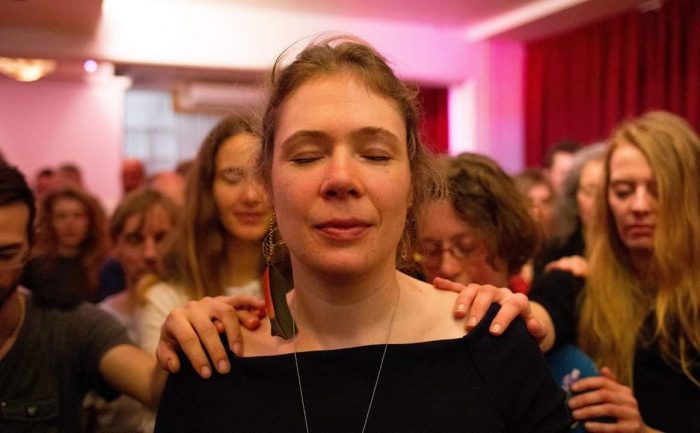Hi. I am a person who creates spaces for people to explore. Who hosts workshops. You could call me a teacher.
I have also been a participant in many workshops on many different topics. Tantra, massage, BDSM, meditation, sexuality, shamanism, trauma healing, you name it. Over the years, there have been things I’ve seen happen that are not cool. Many of them had to do with discomfort from a teacher being projected on their students.
This article is not about the abuse of power dynamics, where teachers use their students for satisfying their personal (sexual or otherwise) needs. There is a lot to be said about that as well. This article is about some other forms of manipulating students for personal gain—specifically, avoiding discomfort.
Some of you may be teachers, others may be students. And maybe you are both. My intention with this article is to shine some light upon dynamics that are not always consciously used.
It’s easier for most teachers when everyone is visibly diving deep into a workshop according to what we believe are signs of deep processes: participation, showing emotions, breakthroughs. But not everyone learns in the same way. Wanting, or even pushing students to show those signs is, in my opinion, manipulative, entitled, and potentially abusive.
These are some of those tactics I see happening in workshops that I believe are more to soothe the discomfort of facilitators than to be of benefit to the students:
Pushing students to participate in exercises.
During my years of facilitating, people sitting out on exercises used to be my number one trigger for insecurity. Did they hate the exercise? Did I not explain it well enough? Did I not build up the workshop well enough?
I believe that one of the most important things we do as facilitators is to empower people in their capacity of making a choice. To support them to trust their own initiative. For some, sitting out an exercise may be the first time (ever for some) to express a “no,” to not go into a pleasing mode, to not do what everyone else is doing.
When I go to someone like that and ask them why they’re not participating, I show them I don’t trust their choice. If I go as far as to discuss their choice, or pressure them into participation, I may break their newfound trust in themselves, and potentially break their boundaries (or push them into breaking their own boundaries) by stepping into something they chose not to step into.
Why do I want everyone to participate? Is it really true that I believe it’s in their best interest (do I know better than they do?), or is it my personal discomfort of people choosing to not participate that I don’t want to deal with?
Nowadays, I tell people at the start of any workshop that they design their own experience, and that they have a full and empowered choice to participate or not—that witnessing is considered full participation. The response to this approach has been amazing: people sit out and often come to me afterward to tell me their appreciation for not being judged or even encouraged to trust their own decisions.
I know of other teachers who claim to offer that space, but still push people to participate and even interrogate them when they chose not to.
Pushing students outside of their comfort zones.
Every time I see that picture of a comfort zone and then magic happening far outside it, I want to scream: “That’s not how it works!” Magic doesn’t happen way out of our comfort zone; that’s where fear happens. It’s a terror zone. When we stretch ourselves too much, our survival mechanisms kick in. We move into fight-or-flight mode, or maybe into freeze mode. At best, we survive. At worst, we retraumatize ourselves.
People have different resiliencies when it comes to tolerating stress. But we don’t learn when we are in survival mode, and we definitely don’t expand our capacities for anything. Magic happens just outside our comfort zone, tiptoeing over the edge to an extent where we still feel safe enough to expand, and challenged enough to ditch old patterns.
This edge is a delicate place. I’ve seen teachers or entire “tantric” schools where the common practice is to push students far outside their comfort zone by exposing them to unexpected and intense exercises and using group pressure or other manipulative techniques to push everyone to participate. I’ve been in a workshop where—before even having had an opening circle in which people share who they are, or having introduced supporting staff—we were told to take all our clothes off and shave the genitals of someone you never met before as a first thing. Not participating would lower the grade we would get in the end, or we were publicly shamed for not being in.
It may seem that people learn this way. Emotional responses in the terror zone can be intense, and our nervous system might give a strong “relief-response” when we come out of the situation, which may feel like a victory over fear. But the next time we meet a similar situation, we will probably experience more fear than before.
Pushing students into catharsis and extreme emotions.
Yes, we can learn through facing pain and reliving it. During our lives, we hide away emotions that were too intense to deal with at the moment. To get rid of those, sooner or later, we need to move through them.
Emotional release sessions, where teachers invite us to hit pillows, scream out loud, or grieve to sad music, can surely be healing. In group settings, they can also be a kickstart for those who have a hard time accessing their emotions.
It’s also quite easy to get people into releasing emotions, even if they don’t have them. Put on some sad music, create a guided meditation where you tell people to think of sad things, someone will start crying, and the rest will follow. Same for anger. Creating a “success,” where everyone feels something, is easy.
But is it right?
I believe emotions are like good whiskey: they need time to ripen. It’s time to release them when the owner of the feeling feels safe and ready to face them.
Strong emotions in a group setting can be overwhelming, intimidating, and even traumatizing for those who aren’t ready.
Another thing that is often forgotten or unknown, is that we learn at least as much through pleasure. In a pleasurable situation, our nervous system is relaxed. We’re not in survival mode. We can actually rewire our brain, patterns, and lives. I’m noticing that many people don’t trust learning through pleasure and fun. There’s a stigma that pleasure is “less deep” than suffering. It may look less serious and feel less deep, and possibly, that’s why it may be a less spectacular format for workshops.
Supporting the idea that depth is measured by decibels.
Spectacularity, the idea that everyone moves into a process, is usually more comfortable as a teacher than processes that are more introverted because we can see something is happening, and that our strategies are successful.
The depth of your experience is never measured by the number of decibels you produce. I’ve seen workshops and sharing circles where teachers applaud loud emotions, and tell people who are silent to “go deeper.”
But you may be a quiet one, or have a quiet day. I know for myself that there were moments where I let go of more sadness without moving a muscle or shedding a tear, than moments of snotty crying.
Now what?
A suggestion for students:
Having said all that, please be mindful of the teachers you choose to learn from. If they try to modify your choices by overruling your autonomy, push you into excessive emotions, or seem to take away from your trust in yourself, you may want to choose differently.
Do note: sometimes teachers don’t want to override your choice but do want to challenge your patterns, gently provoke you outside of your comfort zone, or support you to break down walls. But there’s a difference between the two. The latter will still respect you and will not take your choice personally, or manipulate you from a place of their own discomfort.
A suggestion for teachers:
Whenever someone is choosing to not participate in something, try this: tell them, “Thank you for taking care of yourself.” You basically tell your student you trust them and their choices, and even appreciate them for it. It may change their lives more than any exercise ever could.
And also: learn to feel the difference between your own discomfort and anything else. Your discomfort is yours to deal with, and never your students’ responsibility to solve.
~



Read 1 comment and reply